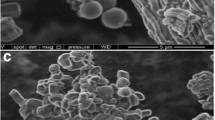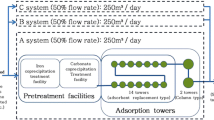Abstract
A Schiff base modified titania (Sal-TiO2) was synthesized and evaluated for eliminating of radioactive Th (IV) ions in comparison with plain TiO2. Thermodynamic studies exhibited that sorption process is entropy-driven onto studied sorbents. Sal-TiO2 exhibited enhanced adsorption properties, and ΔG° of the Sal-TiO2 was around 36% lower. Investigation of linear forms of Langmuir, Freundlich, and Redlich–Peterson adsorption isotherms demonstrated that the adsorption mechanism was in accordance with the Freundlich model. The kinetics of the adsorption onto adsorbents could be well interpreted by pseudo-second-order model. Kinetic and thermodynamic data have been predicted that physisorption is the most possible mechanism for adsorption.











Similar content being viewed by others
References
Aziman ES, Mohd Salehuddin AHJ, Ismail AF (2021) Remediation of thorium (IV) from wastewater: current status and way forward. Sep Purif Rev 50(2):177–202
Humphrey UE, Khandaker MU (2018) Viability of thorium-based nuclear fuel cycle for the next generation nuclear reactor: issues and prospects. Renew Sustain Energy Rev 97:259–275
Darda SA, Gabbar HA, Damideh V, Aboughaly M, Hassen I (2021) A comprehensive review on radioactive waste cycle from generation to disposal. J Radioanal Nucl Chem 329:33
Rahman R, Ibrahium H, Hung Y-T (2011) Liquid radioactive wastes treatment: a review. Water 3(2):551–565
Gao M, Zhu G, Gao C (2014) A review: adsorption materials for the removal and recovery of uranium from aqueous solutions. Energy Environ Focus 3(3):219–226
Gupta VK, Kumar R, Nayak A, Saleh TA, Barakat M (2013) Adsorptive removal of dyes from aqueous solution onto carbon nanotubes: a review. Adv Coll Interface Sci 193:24–34
Li Y, He H, Liu Z, Lai Z, Wang Y (2021) A facile method for preparing three-dimensional graphene nanoribbons aerogel for uranium (VI) and thorium (IV) adsorption. J Radioanal Nucl Chem 328(1):289–298
Anirudhan T, Sreekumari S, Jalajamony S (2013) An investigation into the adsorption of thorium (IV) from aqueous solutions by a carboxylate-functionalised graft copolymer derived from titanium dioxide-densified cellulose. J Environ Radioact 116:141–147
Xu H, Li G, Li J, Chen C, Ren X (2016) Interaction of Th (IV) with graphene oxides: batch experiments, XPS investigation, and modeling. J Mol Liq 213:58–68
Tatarchuk T, Shyichuk A, Mironyuk I, Naushad M (2019) A review on removal of uranium (VI) ions using titanium dioxide based sorbents. J Mol Liq 293:111563
Paschalidou P, Liatsou I, Pashalidis I, Theocharis CR (2017) Effect of surface and textural characteristics on uranium adsorption by nanoporous titania. J Radioanal Nucl Chem 314(2):1141–1147
Wang J, He B, Wei X, Li P, Liang J, Qiang S, Fan Q, Wu W (2019) Sorption of uranyl ions on TiO2: effects of pH, contact time, ionic strength, temperature and HA. J Environ Sci 75:115–123
Altaf AA, Ahmed M, Hamayun M, Kausar S, Waqar M, Badshah A (2020) Titania nano-fibers: a review on synthesis and utilities. Inorg Chim Acta 501:119268
Tel H, Altaş Y, Taner M (2004) Adsorption characteristics and separation of Cr (III) and Cr (VI) on hydrous titanium (IV) oxide. J Hazard Mater 112(3):225–231
Cozzi PG (2004) Metal-Salen Schiff base complexes in catalysis: practical aspects. Chem Soc Rev 33(7):410–421
Masjedi M, Mir N, Noori E, Gholami T, Salavati-Niasari M (2013) Effect of Schiff base ligand on the size and the optical properties of TiO2 nanoparticles. Superlattices Microstruct 62:30–38
Shiri-Yekta Z, Yaftian MR, Nilchi A (2013) Silica nanoparticles modified with a Schiff base ligand: an efficient adsorbent for Th (IV), U (VI) and Eu (III) ions. Korean J Chem Eng 30(8):1644–1651
Janitabar Darzi S, Abdolmohammadi S, Latifi M (2020) Green removal of toxic Th (IV) by amino-functionalized mesoporous TiO2-SiO2 nanocomposite. Iran J Chem Chem Eng (IJCCE) 39(2):191–202
Meroni D, Lo Presti L, Di Liberto G, Ceotto M, Acres RG, Prince KC, Bellani R, Soliveri G, Ardizzone S (2017) A close look at the structure of the TiO2-APTES interface in hybrid nanomaterials and its degradation pathway: an experimental and theoretical study. J Phys Chem C 121(1):430–440
Milanesi F, Cappelletti G, Annunziata R, Bianchi C, Meroni D, Ardizzone S (2010) Siloxane−TiO2 hybrid nanocomposites. The structure of the hydrophobic layer. J Phys Chem C 114(18):8287–8293
Zeitler VA, Brown CA (1957) The infrared spectra of some Ti–O–Si, Ti–O–Ti and Si–O–Si compounds. J Phys Chem 61(9):1174–1177
Shen Z, Zhou H, Chen H, Xu H, Feng C, Zhou X (2018) Synthesis of nano-zinc oxide loaded on mesoporous silica by coordination effect and its photocatalytic degradation property of methyl orange. Nanomaterials 8(5):317
Mokhtari M, Keshtkar AR (2016) Removal of Th (IV), Ni (II) and Fe (II) from aqueous solutions by a novel PAN–TiO2 nanofiber adsorbent modified with aminopropyltriethoxysilane. Res Chem Intermed 42(5):4055–4076
Saravanan P, Jayamoorthy K, Kumar SA (2016) Design and characterization of non-toxic nano-hybrid coatings for corrosion and fouling resistance. J Sci Adv Mater Devices 1(3):367–378
Zhang D, Hegab HE, Lvov Y, Snow LD, Palmer J (2016) Immobilization of cellulase on a silica gel substrate modified using a 3-APTES self-assembled monolayer. Springerplus 5(1):1–20
Cychosz KA, Thommes M (2018) Progress in the physisorption characterization of nanoporous gas storage materials. Engineering 4(4):559–566
Kruk M, Jaroniec M, Sayari A (1997) Application of large pore MCM-41 molecular sieves to improve pore size analysis using nitrogen adsorption measurements. Langmuir 13(23):6267–6273
Yavari R, Asadollahi N, Mohsen MA (2017) Preparation, characterization and evaluation of a hybrid material based on multiwall carbon nanotubes and titanium dioxide for the removal of thorium from aqueous solution. Prog Nucl Energy 100:183–191
Li S, Wang L, Peng J, Zhai M, Shi W (2019) Efficient thorium (IV) removal by two-dimensional Ti2CTx MXene from aqueous solution. Chem Eng J 366:192–199
Ma F, Qu R, Sun C, Wang C, Ji C, Zhang Y, Yin P (2009) Adsorption behaviors of Hg (II) on chitosan functionalized by amino-terminated hyperbranched polyamidoamine polymers. J Hazard Mater 172(2–3):792–801
Lakkaboyana SK, Soontarapa K, Marella RK, Kannan K (2021) Preparation of novel chitosan polymeric nanocomposite as an efficient material for the removal of Acid Blue 25 from aqueous environment. Int J Biol Macromol 168:760–768
Wu L, Ye Y, Liu F, Tan C, Liu H, Wang S, Wang J, Yi W, Wu W (2013) Organo-bentonite-Fe3O4 poly (sodium acrylate) magnetic superabsorbent nanocomposite: synthesis, characterization, and Thorium (IV) adsorption. Appl Clay Sci 83:405–414
Guo Z, Liu X, Huang H (2015) Kinetics and thermodynamics of reserpine adsorption onto strong acidic cationic exchange fiber. PLoS ONE 10(9):e0138619
da Costa ACA, Leite SGF (1991) Metals biosorption by sodium alginate immobilized Chlorella homosphaera cells. Biotech Lett 13(8):559–562
Oliveira LM, Oliveira LF, Sonsin AF, Duarte JL, Soletti JI, Fonseca EJ, Ribeiro LM, Meili L (2020) Ultrafast diesel oil spill removal by fibers from silk-cotton tree: Characterization and sorption potential evaluation. J Clean Prod 263:121448
Abbasizadeh S, Keshtkar AR, Mousavian MA (2013) Preparation of a novel electrospun polyvinyl alcohol/titanium oxide nanofiber adsorbent modified with mercapto groups for uranium (VI) and thorium (IV) removal from aqueous solution. Chem Eng J 220:161–171
Bullen JC, Saleesongsom S, Gallagher K, Weiss DJ (2021) A revised pseudo-second-order kinetic model for adsorption, sensitive to changes in adsorbate and adsorbent concentrations. Langmuir 37(10):3189–3201
Boparai HK, Joseph M, O’Carroll DM (2011) Kinetics and thermodynamics of cadmium ion removal by adsorption onto nano-zerovalent iron particles. J Hazard Mater 186:458–465
Rajahmundry GK, Garlapati C, Kumar PS, Alwi RS, Vo D-VN (2021) Statistical analysis of adsorption isotherm models and its appropriate selection. Chemosphere 276:130176
Zubair M, Aziz HA, Ahmad MA, Ihsanullah I, Al-Harthi MA (2021) Adsorption and reusability performance of M-Fe (M = Co, Cu, Zn and Ni) layered double hydroxides for the removal of hazardous Eriochrome Black T dye from different water streams. J Water Process Eng 42:102060
Wu F-C, Liu B-L, Wu K-T, Tseng R-L (2010) A new linear form analysis of Redlich–Peterson isotherm equation for the adsorptions of dyes. Chem Eng J 162(1):21–27
Al-Ghouti MA, Da’ana DA (2020) Guidelines for the use and interpretation of adsorption isotherm models: a review. J Hazard Mater 393:122383
Veličković Z, Vuković GD, Marinković AD, Moldovan M-S, Perić-Grujić AA, Uskoković PS, Ristić MĐ (2012) Adsorption of arsenate on iron (III) oxide coated ethylenediamine functionalized multiwall carbon nanotubes. Chem Eng J 181:174–181
Kaynar ÜH, Ayvacıklı M, Hiçsönmez Ü, Kaynar SÇ (2015) Removal of thorium (IV) ions from aqueous solution by a novel nanoporous ZnO: isotherms, kinetic and thermodynamic studies. J Environ Radioact 150:145–151
Kapashi E, Kapnisti M, Dafnomili A, Noli F (2019) Aloe Vera as an effective biosorbent for the removal of thorium and barium from aqueous solutions. J Radioanal Nucl Chem 321(1):217–226
Yuan D, Zhang S, Tan J, Dai Y, Wang Y, He Y, Liu Y, Zhao X, Zhang M, Zhang Q (2020) Highly efficacious entrapment of Th (IV) and U (VI) from rare earth elements in concentrated nitric acid solution using a phosphonic acid functionalized porous organic polymer adsorbent. Sep Purif Technol 237:116379
Hamdy G, El-Sabbagh IA, Taher F (2021) Highly efficient sorption of thorium (IV) onto a ternary magnetic TiO2/Fe3O4/GO nanocomposite. Mater Today Proc 42:2218–2226
Mahanty B, Mohapatra PK (2020) Highly efficient separation of thorium from uranium in nitric acid feeds by solid phase extraction using Aliquat 336. Sep Purif Technol 237:116318
Al-Massaedh AA, Khalili FI (2021) Removal of thorium (IV) ions from aqueous solution by polyacrylamide-based monoliths: equilibrium, kinetic and thermodynamic studies. J Radioanal Nucl Chem 327(3):1201–1217
Hu K, Liu Z, Xiu T, Zhou L, Wang Y (2020) Removal of thorium from aqueous solution by adsorption with Cu3(BTC)2. J Radioanal Nucl Chem 326(1):185–192
Li J, Wang X, Zhao G, Chen C, Chai Z, Alsaedi A, Hayat T, Wang X (2018) Metal–organic framework-based materials: superior adsorbents for the capture of toxic and radioactive metal ions. Chem Soc Rev 47(7):2322–2356
Xiu T, Liu Z, Yang L, Wang Y (2019) Removal of thorium and uranium from aqueous solution by adsorption on hydrated manganese dioxide. J Radioanal Nucl Chem 321(2):671–681
Author information
Authors and Affiliations
Corresponding author
Additional information
Publisher's Note
Springer Nature remains neutral with regard to jurisdictional claims in published maps and institutional affiliations.
Rights and permissions
About this article
Cite this article
Yousefipour, K., Janitabar Darzi, S. & Iravani, E. Schiff base-functionalized mesoporous titania: an efficient sorbent for the removal of radioactive thorium ions from aqueous solution. J Radioanal Nucl Chem 332, 2447–2458 (2023). https://doi.org/10.1007/s10967-021-08131-x
Received:
Accepted:
Published:
Issue Date:
DOI: https://doi.org/10.1007/s10967-021-08131-x




